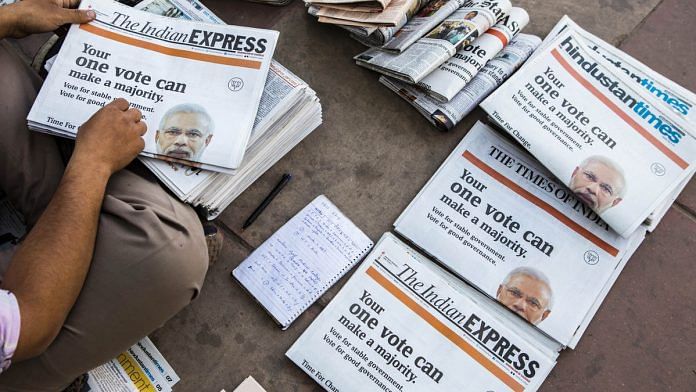New Delhi: Given the high-stakes nature of the 2019 electoral battle and the high-pitched campaign leading up to it, one would expect political advertisements across media to have peaked this year. But that’s not what happened.
The first three months of 2019 saw a massive fall in advertising by political parties, compared to 2014, which were India’s costliest elections ever.
According to data from AdEx India, a division of TAM Media Research, political advertisements on television fell by 83 per cent and print advertisements by 9 per cent between January and March 2019 compared to the corresponding period in 2014.
In 2014, political ads in print media had gone up by 25 per cent compared to 2009, while TV advertising rose by 169 per cent.
Radio advertising is the only space where there has been growth. However, there’s a massive difference here too — the segment had registered a 400 per cent rise in 2014 over 2009, whereas now, it has gone up by just 14 per cent.
The BJP has accounted for the biggest chunk of political advertising this year — its share in terms of ad insertions across print, television and radio is 53 per cent. The Congress is a distant second with 14 per cent, while the Telugu Desam Party is third with 6 per cent.
Neither BJP’s national media head Anil Baluni nor Congress spokesperson Randeep Singh Surjewala responded to messages or calls from ThePrint.
Also read: BJP tops political ad spending on Google at Rs 1.21 crore, Congress comes in sixth
Rush of govt ads before poll code kicked in
Just before the Model Code of Conduct came into effect, on 10 March, advertisements worth crores appeared in multiple editions of newspapers to publicise the achievements of the Narendra Modi government.
The Arvind Kejriwal-led Delhi government also took out several ads in the Delhi editions of mainstream dailies.
However, unlike other political parties, this time the BJP has devised newer ways of publicity — for example, the channel NaMo TV and the “apolitical” interview of Prime Minister Modi by actor Akshay Kumar.
An officer with the Bureau of Outreach Communication, a media unit under the I&B ministry, said the current BJP dispensation in any case does not believe in spending money on print advertisements.
The officer, who handles government advertisements, said: “They feel print advertisements, particularly in national dailies, are mostly a futile exercise as it does not reach the core voter base. That’s a reason they’ve tried to reach out to regional media and editors increasingly. Also, they feel print ads have a limited recall value.”
Fewer print ads during polls
Although data for the month of April is yet to be released, industry sources said political advertisements in print media have seen a drastic fall since the start of elections.
At present, Section 126 of the Representation of the People Act prevents only electronic media from airing political advertisements in the 48 hours before polls. Print and digital media are exempt from this restriction. As a result, political parties usually take out print ads ahead of polling.
Communications consultant Dilip Cherian said the ad-spend for print media during the elections this year is almost half the amount spent on previous elections.
“Moreover, many people are spending on digital media too, creating newer ways of communication, such as videos, memes etc,” Cherian told ThePrint.
“The digital ads are particularly placed on platforms which are accessed on phones.”
However, another industry source, who handles marketing for a prominent national newspaper, said print advertising might not have increased, but there has been no substantial decrease either.
“Political advertising is taking place in regional publications, even though it is somewhat muted in national mainstream dailies. But if you see the other editions of the dailies in constituencies which are going for polls, the ads are there,” the source said.
“Usually, print ads become more prominent and regular as the polling date approaches, not just because they are allowed even during the 48-hour duration, but also because it then has a better recall value. So we have ads lined up for editions relevant to constituencies before they go for polls.”
Also read: New govt will foot the bill for Modi govt’s advertising splurge






